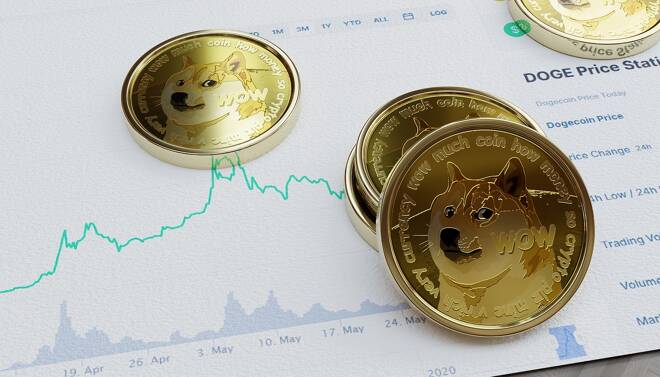Advertisement
Advertisement
3 Dogecoin (DOGE) Price Indicators to Watch after Shiba Inu’s 25% Losses
By:
Key Points:
- Dogecoin price fell below $0.10 on Aug 4, matching Shiba Inu's 8 day losing streak.
- Since July 27, both SHIB and DOGE have registered excess of 25% losses.
- 3 major technical indicators show that DOGE price could experience more volatility in the week ahead.
Dogecoin price Analysis
Dogecoin price fell below $0.10 on Aug 4, matching Shiba Inu’s 8 day losing streak, 3 technical indicators suggest DOGE will likely experience further downside in the week ahead.
DOGE Mirror’s Shiba Inu’s 8-Day Losing Streak
The global memecoin markets has been in a state of turmoil over the past week. Despite mild bearish catalyst from Donald Trump’s recent appearance at the Bitcoin Nashville conference, investors continued to shy away from mega cap memecoins including Dogecoin and Shiba Inu.
Consequently, amid that drop-off in market demand, both DOGE and SHIB the two largest memecoins have posted a starkly similar performance.
The last time Dogecoin experienced positive price action was on July 27, according to TradingView data. Since then, DOGE has closed at a lower price than its opening price, hence the red candles posted in each of the last 8 trading days.
At the writing on Aug 4 DOGE price briefly tumbled below $0.10 reflecting a 28.65% price decline during that period.
More so, the red-shaded area in the lower chart depicts Shiba Inu price action during the same time period. It shows a similar underwhelming performance, with SHIB booking 26.17% losses since the ongoing memecoin market slump began on July 27.
When the two largest memes posting similar price action during a bearish market phase, it suggests the presence of active negative catalysts within the memecoin sub-sector.
Losing the $0.10 level could lead to cascading market liquidations and open DOGE to risks of further downside in the week ahead. These 3 critical technical indicators offer real-time insights supporting this bearish Dogecoin price outlook.
1. RSI Suggests DOGE Price is Nearing Danger Zone
RSI is a momentum oscillator that measures the speed and change of price movements. It ranges from 0 to 100 and is used to identify overbought or oversold conditions in a market.
On the daily DOGE/USD chart, the RSI for Dogecoin has dipped to 34.09, indicating that the asset is nearing oversold conditions.
This level suggests increasing bearish momentum, as the RSI below 50 generally indicates selling pressure. If the RSI continues to fall below 30, it could signal an even stronger bearish trend, pushing DOGE prices further downwards in the week ahead.
2. Choppiness Index also Confirms Downward Volatility
The Choppiness Index is a volatility indicator that quantifies whether the market is trending or trading sideways. Values closer to 100 indicate a choppy market (sideways movement), while values closer to 0 indicate a trending market.
The Choppiness Index for DOGE is at 37.46, indicating that the market is transitioning from a choppy phase to a trending phase. Given the recent price declines, this suggests that the trend is likely bearish. A low Choppiness Index reinforces the potential for sustained downward movement, further supporting the bearish outlook for Dogecoin in the week ahead.
3. DOGE Price Forecast: Bollinger Bands Highlight Critical Support at $0.10
Dogecoin’s recent price action highlights a significant bearish trend as the cryptocurrency trades around $0.105, marking a steep decline from its previous highs.
The Bollinger Bands (20, SMA, close, 2) on the daily chart show an expanding volatility range, with the price now near the lower band, emphasizing the downward pressure. A critical support level to watch is the $0.10 mark, which, if breached, could lead to further losses.
The sharp decline over the past eight days, where DOGE has lost approximately 28.65%, underscores the bearish momentum. The midline of the Bollinger Bands, currently around $0.125, acts as the immediate resistance level. A close above this level would be necessary to indicate any potential bullish reversal. However, the current trend suggests that such a move is unlikely in the short term without significant buying interest.
Further resistance is seen at the upper Bollinger Band near $0.143, which is well above the current price level. The bearish outlook is reinforced by the price consistently closing below the midline, indicating that sellers are in control.
If the $0.10 support fails to hold, DOGE could test lower levels around $0.095 or even $0.090, as the bears capitalize on the weakening technical structure.
About the Author
Ibrahim Ajibadeauthor
Ibrahim Ajibade Ademolawa is a seasoned research analyst with a background in Commercial Banking and Web3 startups, specializing in DeFi and TradFi analysis. He holds a B.A. in Economics and is pursuing an MSc in Blockchain.
Advertisement
